
The Australian lungfish, also known as the Queensland lungfish, Burnett salmon and barramunda, is the only surviving member of the family Neoceratodontidae. It is one of only six extant lungfish species in the world. Endemic to Australia, the Neoceratodontidae are an ancient family belonging to the class Sarcopterygii, or lobe-finned fishes.

Eleotridae is a family of fish commonly known as sleeper gobies, with about 34 genera and 180 species. Most species are found in the tropical Indo-Pacific region, but there are also species in subtropical and temperate regions, warmer parts of the Americas and near the Atlantic coast in Africa. While many eleotrids pass through a planktonic stage in the sea and some spend their entire lives in the sea; as adults, the majority live in freshwater streams and brackish water. One of its genera, Caecieleotris, is troglobitic. They are especially important as predators in the freshwater stream ecosystems on oceanic islands such as New Zealand and Hawaii that otherwise lack the predatory fish families typical of nearby continents, such as catfish. Anatomically, they are similar to the gobies (Gobiidae), though unlike the majority of gobies, they do not have a pelvic sucker.

The footballfish form a family, Himantolophidae, of globose, deep-sea anglerfishes found in tropical and subtropical waters of the Atlantic, Indian, and Pacific Ocean. The family contains 23 species, all of which reside in a single genus, Himantolophus.

The New Zealand smelt, also known as the New Zealand common smelt, New Zealand cucumber fish, or silveries is a smelt of the family Retropinnidae, found only in New Zealand at shallow depths in estuaries and rivers. Their length is between 8 and 13 cm.
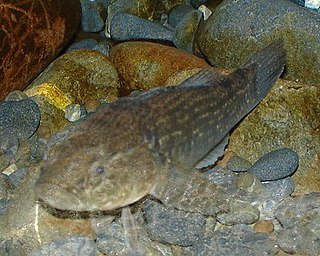
The giant bully, tītarakura, or tīpokopoko (Māori), is a species of fish in the family Eleotridae endemic to New Zealand.
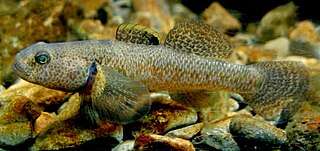
The upland bully is a species of fish in the family Eleotridae endemic to freshwater habitats in New Zealand. Both sexes have distinctive orange-brown dots all over the head. Adults generally reach a length of 8–10 cm (3.1–3.9 in).

Cran's bully is a species of fish in the family Eleotridae endemic to New Zealand, where it is only found in fresh waters. This species can reach a length of 9 cm (3.5 in).
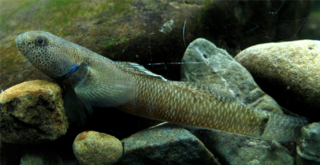
The bluegill bully is a fish in the family Eleotridae that is endemic to New Zealand. It lives in shallow, fast-flowing riffles and torrents, where it forages and shelters amongst the gravels. It has a similar distribution to the other endemic riffle specialist, the torrentfish. It can be found up to 100 kilometres (62 mi) inland, and from sea level up to an elevation of 480 metres (1,570 ft). The bluegill bully is the smallest of the Eleotrids, commonly reaching only 60–70 mm (2.4–2.8 in).

The redfin bully is a species of freshwater fish in the family Eleotridae endemic to New Zealand. Being amphidromous, it spends part of its life cycle at sea. Males have distinctive bright red patterns and stripes on their fins. Adults grow to an average of 80–100 mm (3.1–3.9 in) total length, with a maximum of 120 mm (4.7 in).
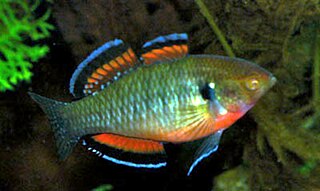
Hypseleotris is a genus of fishes in the family Eleotridae. Most are from fresh water in Australia and New Guinea, but species in fresh and brackish water are found around islands in the western Indian Ocean, southern and eastern Africa, southern and eastern Asia, and Pacific islands. The largest species reaches a length of 12 cm (4.7 in). They are sometimes seen in the aquarium trade; especially H. compressa. In Australia they are known as carp gudgeons.

Oxyeleotris is a genus of sleeper gobies mostly restricted to Australia and New Guinea, though some are found in Southeast Asia.
Lake Lenthall is a lake created by the Lenthalls Dam in Duckinwilla, Fraser Coast Region, Queensland, Australia. As a result of a 518 square kilometres (200 sq mi) catchment, it takes a short time in moderate rain events to fill Lake Lenthall to 100% capacity.

Gerald Stokell was a New Zealand amateur ichthyologist.
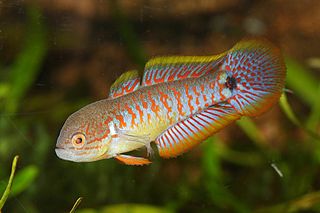
The peacock gudgeon or peacock goby is a tropical freshwater species of fish in the family Eleotridae that is endemic to the eastern part of Papua New Guinea. It can be found in schools hovering over the substrate in rivers and ponds. This species can reach a length of 7.5 cm (3.0 in). It is currently the only known member of its genus.

Gobio gobio, or the gudgeon, is a species of fish in the family Cyprinidae. This small fish is widely distributed in fresh-water streams and lakes across central and temperate Eurasia.

Philypnodon is a genus of fishes in the family Eleotridae endemic to Australia and the coastal waters around it.

Hypseleotris compressa, the empire gudgeon, is a species of Gobiiform fish in the family Eleotridae endemic to Australia and south-central New Guinea.

Gobiomorphus australis, the striped gudgeon, is a fish in the family Eleotridae, native to eastern Australia. It can be found in a wide variety of habitats from clear streams with rapid currents to muddy stillwaters such as ponds and waterholes. Juveniles are common in estuaries near rocks, submerged logs and among vegetation. They are good climbers and are able to clamber over wet rocky surfaces such as rapids and waterfalls.

The flathead gudgeon is a species of fish in the family Eleotridae endemic to eastern Australia.

Gobiomorphus coxii, or Cox's gudgeon, is a species of sleeper goby in the family Eleotridae which is native to the upland rivers of south eastern Australia.


















